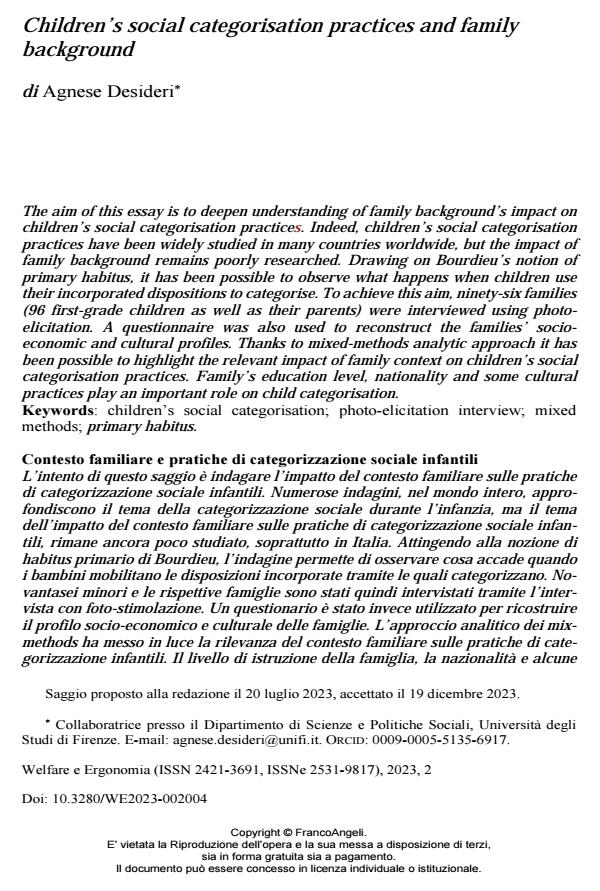Children’s social categorisation practices and family background
Titolo Rivista WELFARE E ERGONOMIA
Autori/Curatori Agnese Desideri
Anno di pubblicazione 2024 Fascicolo 2023/2
Lingua Inglese Numero pagine 14 P. 43-56 Dimensione file 219 KB
DOI 10.3280/WE2023-002004
Il DOI è il codice a barre della proprietà intellettuale: per saperne di più
clicca qui
Qui sotto puoi vedere in anteprima la prima pagina di questo articolo.
Se questo articolo ti interessa, lo puoi acquistare (e scaricare in formato pdf) seguendo le facili indicazioni per acquistare il download credit. Acquista Download Credits per scaricare questo Articolo in formato PDF

FrancoAngeli è membro della Publishers International Linking Association, Inc (PILA)associazione indipendente e non profit per facilitare (attraverso i servizi tecnologici implementati da CrossRef.org) l’accesso degli studiosi ai contenuti digitali nelle pubblicazioni professionali e scientifiche
The aim of this essay is to deepen understanding of family background’s impact on children’s social categorisation practices. Indeed, children’s social categorisation practices have been widely studied in many countries worldwide, but the impact of family background remains poorly researched. Drawing on Bourdieu’s notion of primary habitus, it has been possible to observe what happens when children use their incorporated dispositions to categorise. To achieve this aim, ninety-six families (96 first-grade children as well as their parents) were interviewed using photo-elicitation. A questionnaire was also used to reconstruct the families’ socio-economic and cultural profiles. Thanks to mixed-methods analytic approach it has been possible to highlight the relevant impact of family context on children’s social categorisation practices. Family’s education level, nationality and some cultural practices play an important role on child categorisation.
L’intento di questo saggio è indagare l’impatto del contesto familiare sulle pratiche di categorizzazione sociale infantili. Numerose indagini, nel mondo intero, approfondiscono il tema della categorizzazione sociale durante l’infanzia, ma il tema dell’impatto del contesto familiare sulle pratiche di ca-tegorizzazione sociale infantili, rimane ancora poco studiato, soprattutto in Italia. Attingendo alla nozione di habitus primario di Bourdieu, l’indagine permette di osservare cosa accade quando i bambini mobilitano le disposizio-ni incorporate tramite le quali categorizzano. Novantasei minori e le rispetti-ve famiglie sono stati quindi intervistati tramite l’intervista con foto-stimolazione. Un questionario è stato invece utilizzato per ricostruire il profi-lo socio-economico e culturale delle famiglie. L’approccio analitico dei mix-methods ha messo in luce la rilevanza del contesto familiare sulle pratiche di categorizzazione infantili. Il livello di istruzione della famiglia, la nazionalità e alcune pratiche culturali hanno un impatto importante sulle pratiche di ca-tegorizzazione dei bambini.
Parole chiave:categorizzazione sociale dei bambini; photo-elicitation inter-view; metodi misti; habitus primario.
Agnese Desideri, Children’s social categorisation practices and family background in "WELFARE E ERGONOMIA" 2/2023, pp 43-56, DOI: 10.3280/WE2023-002004